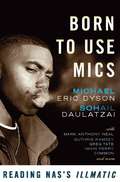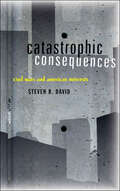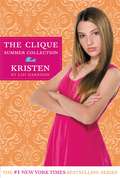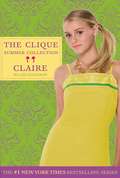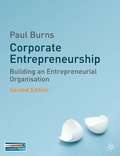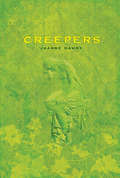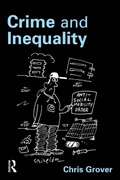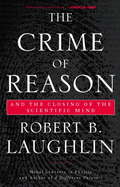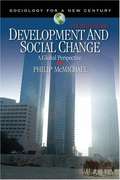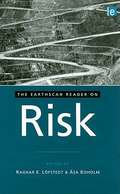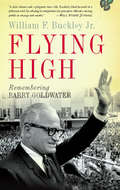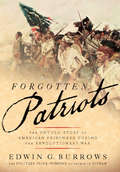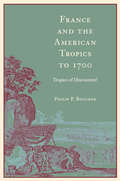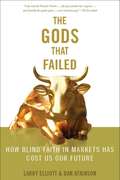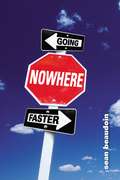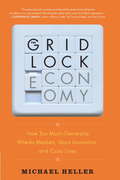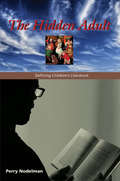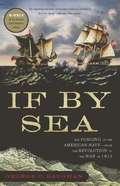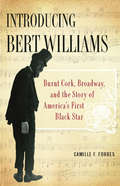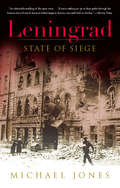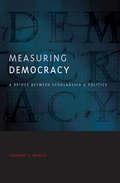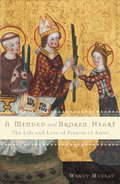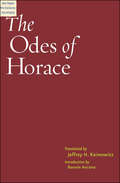- Table View
- List View
Born to Use Mics: Reading Nas's Illmatic
by Michael Eric Dyson; Sohail DaulatzaiAt the age of nineteen, Nasir "Nas" Jones began recording tracks for his debut album -- and changed the music world forever. Released in 1994, Illmatic was hailed as an instant masterpiece and has proven one of the most influential albums in hip-hop history. With its close attention to beats and lyricism, and riveting first-person explorations of the isolation and desolation of urban poverty, Illmatic was pivotal in the evolution of the genre. In Born to Use Mics, Michael Eric Dyson and Sohail Daulatzai have brought together renowned writers and critics including Mark Anthony Neal, Marc Lamont Hill, Eddie S. Glaude, Jr., and many others to confront Illmatic song by song, with each scholar assessing an individual track from the album. The result is a brilliant engagement with and commentary upon one of the most incisive sets of songs ever laid down on wax.
Catastrophic Consequences: Civil Wars and American Interests
by Steven R. DavidCivil war and other types of radical domestic upheaval are replacing international war as the preeminent threat to American security and economic well being, according to Steven R. David. Catastrophic Consequences argues that civil conflicts are of even greater importance than deliberate efforts to harm the United States because the damage they inflict is unintended and therefore impossible to deter.David examines the prospects for and potential aftereffects of instability in four nations vital to U.S. national interests—Saudi Arabia, Pakistan, China, and Mexico. It is not, he argues, a rising China that threatens America, but one that is falling apart. Likewise, it is not a hostile Pakistani regime over which the United States should worry, rather it is one that cannot keep the country together. Similarly, a conflict-torn Mexico or Saudi Arabia poses a far greater danger to America than does either of those states growing stronger. In assessing these threats, David contends that the United States’s only viable option is to view other-state civil upheaval similarly to natural disasters and to develop a coherent, effective emergency response mechanism, which does not exist today in any systemic, nationwide form.
Clique Summer Collection #4:Kristen (The Clique #No. 4)
by Lisi HarrisonKristen sets sail on the Love Boat... With the rest of the Pretty Committee scattered across the globe, Kristen is stuck in summer school at OCD, making good on her scholarship commitments. No sleepover horse camp, no Hawaiian spa, no Spanish vacation, not even a trip to Orlando. But when Kristen scores a job looking after hang-ten hottie Dune Baxter's eight-year-old sister, Ripple, Westchester suddenly doesn't seem so bad. It looks like Kristin is about to ride the wave of first love. . . .
Clique Summer Collection #5: Claire (The Clique #Bk. 5)
by Lisi HarrisonWill Claire's Florida BFFs become former BFFs? Back in Orlando for the summer, Claire is reunited with her Florida best friends, Sarah, Sari, and Mandy, after a long year apart. Her FBFs haven't changed at all. Too bad they think Claire has . . . and not for the better. Claire sets out to prove her loyalty by entering Kissimmee's Miss Kiss pageant. But when a very special visitor shows up and vows to win the crown, Claire finds herself torn between Keds and couture. Will Claire finally kiss-immee her past goodbye-once and for all?
Corporate Entrepreneurship: Building An Entrepreneurial Organization (PDF)
by Paul BurnsThis book offers an innovative look at the entrepreneurial advantage and how it can be harnessed and replicated within organizations, transforming them into market leaders. It is a UK authored Corporate Entrepreneurship textbook, authored by Paul Burns, Dean of Bedfordshire Business School and author of one of the bestselling core entrepreneurship textbooks. It includes real world case studies and quotations from entrepreneurial managers, strong pedagogy, step-by-step Corporate Entrepreneurship Audit, links to further reading and additional resources, and a companion website which provides additional resources for students and lecturers.
Creepers
by Joanne DahmeFrom moving to a new house to making new friends and preparing for high school, life for the new girl in town can be unsettling. But thirteen year-old Courtney is unprepared for how creepy life in Murmur, Massachusetts turns out to be. Her ivy-covered house overlooking the antiquated cemetery next door is one thing, but Courtney finds herself thrust into a full-fledged haunted adventure after meeting Christian and Margaret Geyer, a strange father and daughter with unfinished family business. The body of their ancestor, Prudence, has gone missing from beneath her ivy-carved tombstone and must be returned to its final resting place in order to break the spell that looms over Courtney's house. To add to the suspense and help solve the mystery, authentic documents and photographs are set at the beginning of each chapter pertaining to Murmur, Courtney's house, and the infamous cemetery. Will Courtney uncover the secret lurking within the dark, dank underbelly of her ivy-covered basement?
Crime and Inequality
by Chris GroverThis book examines key relationships between material circumstances and crime, and analyzes the areas of social policy - in particular social security and labour market policy - that are most important in terms of dealing with inequality at the lower end of the income hierarchy. It seeks to explain why inequality is linked to offending behaviour and the evidence underpinning explanations for this, and looks in detail at the relationship between offending and anti-social behaviour and its management through social policy interventions. Crime and Inequality draws upon both criminological and social policy approaches to understand this vital relationship, moving beyond criminological approaches which often fail to analyse the way the state attempts to manage poor material circumstance, offending and anti-social behaviour through social policy. The main aims of the book are threefold: to draw upon the disciplines of both criminology and social policy to understand the relationship between crime and inequality; to provide an in-depth analysis of those aspects of social policy that have a bearing on the context, management and punishment of offending behaviour; to examine government crime and anti-social behaviour policies in the context of social security and labour market policies, and to identify the tensions that have resulted from attempts to address social justice issues while also making individuals responsible for their actions. Alternate ISBN 9781843923305
The Crime of Reason: And the Closing of the Scientific Mind
by Robert B. LaughlinWe all agree that the free flow of ideas is essential to creativity. And we like to believe that in our modern, technological world, information is more freely available and flows faster than ever before. But according to Nobel Laureate Robert Laughlin, acquiring information is becoming a danger or even a crime. Increasingly, the really valuable information is private property or a state secret, with the result that it is now easy for a flash of insight, entirely innocently, to infringe a patent or threaten national security. The public pays little attention because this vital information is "technical”-but, Laughlin argues, information is often labeled technical so it can be sequestered, not sequestered because it's technical. The increasing restrictions on information in such fields as cryptography, biotechnology, and computer software design are creating a new Dark Age: a time characterized not by light and truth but by disinformation and ignorance. Thus we find ourselves dealing more and more with the Crime of Reason, the antisocial and sometimes outright illegal nature of certain intellectual activities.The Crime of Reason is a reader-friendly jeremiad, On Bullshit for the Slashdot and Creative Commons crowd: a short, fiercely argued essay on a problem of increasing concern to people at the frontiers of new ideas.
Development and Social Change: A Global Perspective (PDF)
by Philip McmichaelSituating development as a world-historical project, this text traces its contours across three historical periods: colonialism, the development era, and the era of globalization. McMichael shows how the social transformations from colonial subjects, through national citizens, to global consumers have been inspired and managed through successive projects of development, ordering a changing and unequal world. This fourth edition accentuates ecological themes, the gendering of development, and alternative development visions. Updating showcases the paradox of the development lifestyle, ecological footprints, the war on poverty, social reproduction issues, the planet of slums phenomenon, outsourcing, African re-colonization, the Latin rebellion against neo-liberalism, the rise of China and India, and the ever-changing policy face of the development establishment as it seeks to retain or renew its legitimacy at a time when development is perhaps facing its greatest challenge in the ecologically, socially, and politically destabilizing impacts of climate change.
Earthscan Reader Series: The Earthscan Reader on Risk (PDF)
by Ragnar LofstedtThis new anthology is a comprehensive introduction to the field of risk theory. The introduction provides the ideal starting point for students and professionals new to risk studies and offers a concise refresher for researchers and practitioners. Coverage includes the origins of the 'concept of risk' and its often misunderstood cousin 'uncertainty,' before moving on to address risk perception, risk communication, the idea of trust and post trust as well as risk in policy and regulation with a close look at the Precautionary Principle. Following the introduction, the volume includes a selection of the most significant and influential works on risk in their entirety. These selections, organized thematically to cover the breadth and depth of the field, provide greater detail and elaborate on the key themes and major developments in risk studies. Together they comprise the essential literature necessary for a full understanding of risk theory and practice on any issue and in any context.
Flying High: Remembering Barry Goldwater
by William F. Buckley Jr.In Flying High, William F. Buckley Jr. offers his lyrical remembrance of a singular era in American politics, and a tribute to the modern Conservative movement's first presidential standard-bearer, Barry Goldwater. Goldwater was in many ways the perfect candidate: self-reliant, unpretentious, unshakably honest, and dashingly handsome. And although he lost the election, he electrified millions of voters with his integrity and a sense of decency-qualities that made him a natural spokesman for Conservative ideals and an inspiration for decades to come.In an era when Republicans are looking for a leader, Flying High is a reminder of how real political visionaries inspire devotion.
Flying High: Remembering Barry Goldwater
by William F. Buckley Jr.If any two people can be called indispensable in launching the conservative movement in American politics, they are William F. Buckley Jr. and Barry Goldwater. Buckley's National Review was at the center of conservative political analysis from the mid-fifties onward. But the policy intellectuals knew that to actually change the way the country was run, they needed a presidential candidate, and the man they turned to was Arizona Senator Barry Goldwater. Goldwater was in many ways the perfect choice: self-reliant, unpretentious, unshakably honest and dashingly handsome, with a devoted following that grew throughout the fifties and early sixties. He possessed deep integrity and a sense of decency that made him a natural spokesman for conservative ideals. But his flaws were a product of his virtues. He wouldn't't bend his opinions to make himself more popular, he insisted on using his own inexperienced advisors to run his presidential campaign, and in the end he electrified a large portion of the electorate but lost the great majority. Flying High is Buckley's partly fictional tribute to the man who was in many ways his alter ego in the conservative movement. It is the story of two men who looked as if they were on the losing side of political events, but were kept aloft by the conviction that in fact they were making history.
Forgotten Patriots: The Untold Story of American Prisoners During the Revolutionary War (Playaway Adult Nonfiction Ser.)
by Edwin G. BurrowsBetween 1775 and 1783, some 200,000 Americans took up arms against the British Crown. Just over 6,800 of those men died in battle. About 25,000 became prisoners of war, most of them confined in New York City under conditions so atrocious that they perished by the thousands. Evidence suggests that at least 17,500 Americans may have died in these prisons-more than twice the number to die on the battlefield. It was in New York, not Boston or Philadelphia, where most Americans gave their lives for the cause of independence.New York City became the jailhouse of the American Revolution because it was the principal base of the Crown's military operations. Beginning with the bumper crop of American captives taken during the 1776 invasion of New York, captured Americans were stuffed into a hastily assembled collection of public buildings, sugar houses, and prison ships. The prisoners were shockingly overcrowded and chronically underfed-those who escaped alive told of comrades so hungry they ate their own clothes and shoes.Despite the extraordinary number of lives lost, Forgotten Patriots is the first-ever account of what took place in these hell-holes. The result is a unique perspective on the Revolutionary War as well as a sobering commentary on how Americans have remembered our struggle for independence-and how much we have forgotten.
France and the American Tropics to 1700: Tropics of Discontent?
by Philip P. BoucherTraditionally, the story of the Greater Caribbean has been dominated by the narrative of Iberian hegemony, British colonization, the plantation regime, and the Haitian Revolution of the eighteenth century. Relatively little is known about the society and culture of this region—and particularly France's role in them—in the two centuries prior to the rise of the plantation complex of the eighteenth century. Here, historian Philip P. Boucher offers the first comprehensive account of colonization and French society in the Caribbean. Boucher's analysis contrasts the structure and character of the French colonies with that of other colonial empires. Describing the geography, topography, climate, and flora and fauna of the region, Boucher recreates the tropical environment in which colonists and indigenous peoples interacted. He then examines the lives and activities of the region's inhabitants—the indigenous Island Caribs, landowning settlers, indentured servants, African slaves, and people of mixed blood, the gens de couleur. He argues that the sixteenth and seventeenth centuries were not merely a prelude to the classic plantation regime model. Rather, they were an era presenting a variety of possible outcomes. This original narrative demonstrates that the transition to sugar and the plantation complex was more gradual in the French properties than generally depicted—and that it was not inevitable.
The Gods that Failed: How Blind Faith in Markets Has Cost Us Our Future
by Larry Eliott Dan AtkinsonOver the past three decades, governments have ceded economic control to a new elite of free-market operatives and their colleagues in national and international institutions like the IMF, the World Bank, and the World Trade Organization. They promised economic stability but have delivered chaos. Their speculation has left the global economy more vulnerable to a financial collapse than any time since 1929.Two leading financial journalists dissect this financial elite, tracing their origins to a secretive gathering of free-market economists in 1947, and propose a series of far-reaching reforms that can save us from a new depression.
Going Nowhere Faster
by Sean BeaudoinEveryone in town thought Stan was going to be something and go somewhere, but they're starting to realize that when this boy genius can't even get out of Happy Video, he's going nowhere, faster. But when things look like they're only getting worse, Stan is forced to decide what he wants to do with his life. Suddenly, he may be getting somewhere afterall. With sarcastic, dry wit reminiscent of David Sedaris and Tom Perrotta, this debut YA novel delivers with laugh-out-loud hilarity and a lot of heart.
The Gridlock Economy: How Too Much Ownership Wrecks Markets, Stops Innovation, and Costs Lives
by Michael HellerTwenty-five new runways would eliminate most air travel delays in America; fifty patent owners are blocking a major drug company from creating a cancer cure; 90 percent of our broadcast spectrum sits idle while American cell phone service suffers. These problems have solutions that can jump-start innovation and help save our troubled economy. So, what's holding us back?Michael Heller, a leading authority on property, reveals that while private ownership creates wealth, too much ownership means that everyone loses. Startling and accessible, The Gridlock Economy offers insights on how we can overcome this preventable paradox.
The Hidden Adult: Defining Children's Literature
by Perry NodelmanWhat exactly is a children’s book? How is children’s literature defined as a genre? A leading scholar presents close readings of six classic stories to answer these questions and offer a clear definition of children’s writing as a distinct literary form. Perry Nodelman begins by considering the plots, themes, and structures of six works: "The Purple Jar," Alice in Wonderland, Dr. Doolittle, Henry Huggins, The Snowy Day, and Plain City—all written for young people of varying ages in different times and places—to identify shared characteristics. He points out markers in each work that allow the adult reader to understand it as a children’s story, shedding light on ingrained adult assumptions and revealing the ways in which adult knowledge and experience remain hidden in apparently simple and innocent texts.Nodelman then engages a wide range of views of children's literature from authors, literary critics, cultural theorists, and specialists in education and information sciences. Through this informed dialogue, Nodelman develops a comprehensive theory of children's literature, exploring its commonalities and shared themes. The Hidden Adult is a focused and sophisticated analysis of children’s literature and a major contribution to the theory and criticism of the genre.
If By Sea: The Forging of the American Navy--from the Revolution to the War of 1812
by George C. DaughanThe American Revolution-and thus the history of the United States-began not on land but on the sea. Paul Revere began his famous midnight ride not by jumping on a horse, but by scrambling into a skiff with two other brave patriots to cross Boston Harbor to Charlestown. Revere and his companions rowed with muffled oars to avoid capture by the British warships closely guarding the harbor. As they paddled silently, Revere's neighbor was flashing two lanterns from the belfry of Old North Church, signaling patriots in Charlestown that the redcoats were crossing the Charles River in longboats. In every major Revolutionary battle thereafter the sea would play a vital, if historically neglected, role. When the American colonies took up arms against Great Britain, they were confronting the greatest sea-power of the age. And it was during the War of Independence that the American Navy was born. But following the British naval model proved crushingly expensive, and the Founding Fathers fought viciously for decades over whether or not the fledgling republic truly needed a deep-water fleet. The debate ended only when the Federal Navy proved indispensable during the War of 1812. Drawing on decades of prodigious research, historian George C. Daughan chronicles the embattled origins of the U.S. Navy. From the bloody and gunpowder-drenched battles fought by American sailors on lakes and high seas to the fierce rhetorical combat waged by the Founders in Congress, If By Sea charts the course by which the Navy became a vital and celebrated American institution.
Introducing Bert Williams: Burnt Cork, Broadway, and the Story of America's First Black Star
by Camille F. ForbesAccording to critics of his time, Bert Williams was "the Greatest Comedian on the American Stage.” A black Bahamian immigrant, Williams made his start as a barker advertising the rough-and-tumble "medicine shows” that dotted the Wild West at the end of the nineteenth century. Not long after joining a minstrel troupe and donning the burnt- cork makeup of blackface, he teamed up with African American George Walker in a sixteen-year partnership that would take them from rural western mining towns to the bright lights of Broadway.In Introducing Bert Williams, historian Camille Forbes reveals a fascinating figure, initiating the reader into the vivid world of nineteenth- and early twentieth-century popular entertainment. Williams's long and varied career is a whirlwind of drama, glamour, and ambition-nothing less than the birth of American show business.
Leningrad: State of Siege
by Michael Jones"All offers of surrender from Leningrad must be rejected,” wrote Adolph Hitler on September 29, 1941, at the outset of Operation Barbarossa. "In this struggle for survival, we have no interest in keeping even a proportion of the city's population alive.”During the famed 900-day siege of Leningrad, the German High Command deliberately planned to eradicate the city's population through starvation. Viewing the Slavs as sub-human, Hitler embarked on a vicious program of ethnic cleansing. By the time the siege ended in January 1944, almost a million people had died. Those who survived would be marked permanently by what they endured as the city descended into chaos.In Leningrad, military historian Michael Jones chronicles the human story of this epic siege. Drawing on newly available eyewitness accounts and diaries, he reveals the true horrors of the ordeal-including stories long-suppressed by the Soviets of looting, criminal gangs, and cannibalism. But he also shows the immense psychological resources on which the citizens of Leningrad drew to survive against desperate odds. At the height of the siege, for instance, an extraordinary live performance of Shostakovich's Seventh Symphony profoundly strengthened the city's will to resist.A riveting account of one of the most harrowing sieges of world history, Leningrad also portrays the astonishing power of the human will in the face of even the direst catastrophe.
Measuring Democracy: A Bridge between Scholarship and Politics (Democratic Transition and Consolidation)
by Gerardo L. MunckAlthough democracy is a widely held value, concrete measurement of it is elusive. Gerardo L. Munck’s constructive assessment of the methods used to measure democracies promises to bring order to the debate in academia and in practice.Drawing on his years of academic research on democracy and measurement and his practical experience evaluating democratic practices for the United Nations and the Organization of American States, Munck's discussion bridges the theories of academia with practical applications. In proposing a more open and collaborative relationship between theory and action, he makes the case for reassessing how democracy is measured and encourages fundamental changes in methodology. Munck’s field-tested framework for quantifying and qualifying democracy is built around two instruments he developed: the UN Development Programme’s Electoral Democracy Index and a case-by-case election monitoring tool used by the OAS.Measuring Democracy offers specific, real-world lessons that scholars and practitioners can use to improve the quality and utility of data about democracy.
A Mended and Broken Heart: The Life and Love of Francis of Assisi
by Wendy MurrayFrancis of Assisi is Catholicism&’s most popular saint. Tens of millions of spiritual seekers summon his name and example. But the real Francis-both his complicated personality and his complex theology-have been misunderstood for centuries. In 1228, Pope Gregory IX rushed to canonize St. Francis only two years after his death. Soon thereafter, the Church eliminated significant aspects of his biography from the public record. For Francis&’s early life was defined by his profligacy; shortly before dying, Francis himself warned his brothers: &“Don&’t be too quick to canonize me. I am perfectly capable of fathering a child.&” In A Mended and Broken Heart, journalist Wendy Murray slices through the bowdlerized version of Francis&’s life promoted within the Catholic tradition and reveals instead a saint who was in every way also a real man. Murray stresses in particular the crucial but completely neglected role that Clare of Assisi played in Francis&’s life, both pre- and postconversion, and his theology. A profoundly humane portrait of a misunderstood saint, A Mended and Broken Heart makes a powerful case that St. Francis&’s life and thought make him a role model for religious seekers of every faith.
Mere Thermodynamics
by Don S. LemonsPresenting classical thermodynamics as a concise and discrete whole, Mere Thermodynamics is a perfect tool for teaching a notoriously difficult subject.Accomplished teacher Don S. Lemons introduces the physical theory's concepts and methods and uses them to solve problems from a broad range of physics. He illustrates, at a gentle pace, not only the fundamentals of the subject but also advanced topics such as the relationship between the second law of thermodynamics and entropy. He highlights the intellectual structure and history of the discipline and explores the logical consequences of each of the famous three laws. Lemons explains and develops the first two laws and their corollaries, the methods and applications of thermodynamics, and the third law, as well as non-fluid variables, equilibrium and stability, and two-phase systems.The book features end-of-chapter practice problems, an appendix of worked problems, a glossary of terms, and an annotated bibliography.
The Odes of Horace (Johns Hopkins New Translations from Antiquity)
by Horace (Quintus Horatius Flaccus)This groundbreaking new translation of Horace’s most widely read collection of poetry is rendered in modern, metrical English verse rather than the more common free verse found in many other translations. Jeffrey H. Kaimowitz adapts the Roman poet's rich and metrically varied poetry to English formal verse, reproducing the works in a way that maintains fidelity to the tone, timbre, and style of the originals while conforming to the rules of English prosody. Each poem is true to the sense and aesthetic pleasure of the Latin and carries with it the dignity, concision, and movement characteristic of Horace’s writing. Kaimowitz presents each translation with annotations, providing the context necessary for understanding and enjoying Horace's work. He also comments on textual instability and explains how he constructed his verse renditions to mirror Horatian Latin. Horace and The Odes are introduced in lively fashion by noted classicist Ronnie Ancona.
